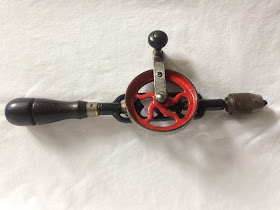Hand tool woodworkers are periodically confronted with a dilemma: either the tool you want is no longer in production, or, if it is once again being made, it's pretty expensive. Tools manufactured to a handyman's price point are almost never of adequate quality. Buying a cheap tool and then having to replace it because of its defects wastes both time and money.
One way out of this dilemma is obvious: buy used tools. Yes, you will make mistakes, but typically those mistakes will cost you less than buying a new tool of poor quality and then having to replace it with a better one. One old tool I especially like is an eggbeater hand drill with double pinion gears made nearly 100 years ago by Millers Falls. Here is a picture of my well-used Millers Falls No. 1.
My reasons for liking this drill are simple: if I'm restoring a piece of antique furniture, I try to take it slow and carefully. An electric drill is indispensable, but it can go zzzzzp! and suddenly you have a hole to patch, one that due to Sod's Law is always in the worst possible place. Cranking a hand drill, you proceed slowly, so you have ample time to realize you are on the verge of making a mistake.
These eggbeater drills are pretty straightforward, but I don't recommend buying one sight unseen. One or more of the three jaws in the chuck can be missing, screws can have vanished, and the handles of older ones--they started being made in the late 19th Century--can be cracked. If the drill is otherwise fine, cracks in the handle can be re-glued with Hot Stuff, a glue with no surface tension that wicks into cracks. The No. 1 has a bit container in the handle, but the eight bits may or may not be there. For me, that's not important because the chuck accepts drill bits up to 13/64".
At some point, you may consider repainting the drill. I rather like the indications of honest use on a wooden tool: they remind me of the better woodworkers who used this tool before, and imitation is the first step toward mastery. But badly worn paint seems a different matter, and I recently felt the urge to restore the paint on my Millers Falls. After all, these drills when new were meant to call attention to themselves: the wood on my No. 1 is cocobolo; what now appears to be a brass collar was nickel plated; and the iron frame was splendid in glossy black with the drive wheel in glossy red.
A local hobby store had a wide selection of gloss enamels, including a red that replicated what the now faded remnants must have looked like when new. I unscrewed the drill's handle, unscrewed and lifted off the drive wheel, and scraped the chipped black paint off the frame. After lightly sanding the metal and degreasing it with brake cleaner, I applied two coats of enamel. To my eye, it looks much better than it did: decidedly not new, but better cared for. Some Break-Free CLP in the two lubrication holes on the back of the frame and some dry lube on the gears made it run even more smoothly.
If you want to have the ultimate version of this kind of drill, check out two websites. One is Wiktor Kuc's website. According to Christopher Schwarz, when Wiktor Kuc has finished restoring a Millers Falls drill, it's better than new. The other is Ted Hoeft's at Lone Pine Toolworks: he restores a variety of tools, charging according to the amount of work involved. Judging by his photos, he does beautiful work.
For myself, I'm happy with the middle road between buying a remade drill meticulously restored and buying a ratty one and leaving it alone: that five dollars I spent on gloss enamel and the few hours I spent cleaning, painting, and lubricating it have resulted in a Millers Falls No.1 that looks as good as it works. Come to think of it, a couple of coats of Tru-Oil would bring up the sheen of the cocobolo handle and knob and make it look even better.

